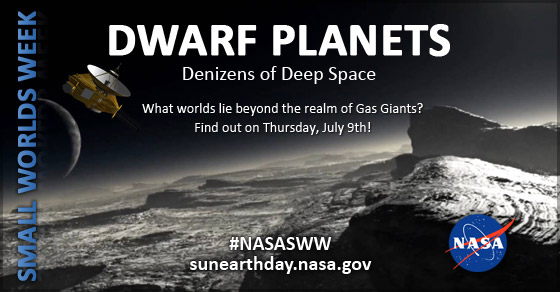
Join the discussion with NASA planetary scientists during Small Worlds Week, July 6-10!
The eight planets of our solar system can be divided neatly into two categories; terrestrial planets - small, rocky, dense; and gas giants - large, gaseous, and not dense. Beyond that we have the dwarf planets - small, icy worlds, orbiting largely outside the orbit of Neptune (Ceres is an exception), in highly elliptical orbits. These worlds do not satisfy all three conditions, set by the International astronomical Union (IAU) for planethood. They are too small.

Lucy McFadden investigates the surface composition of the solar system's small bodies: asteroids, comets, and meteorites. She is a Co-Investigator on NASA's Dawn mission to the asteroids Vesta and Ceres and was Co-I on NASA’s Deep Impact mission that impacted Comet Tempel 1 a decade ago, this week. Prior to that, McFadden was a member of the science team for the Near Earth Asteroid Rendezvous mission, which landed a spacecraft on the asteroid Eros in 2001. In addition to these studies, she collected meteorites as a member of the 2007-2008 expedition of the Antarctic Search for Meteorites (ANSMET) and participated in the fourth recovery expedition for Almahata Sitta meteorite in the Sudan in 2009.
She is interested in exploring anything related to the natural world, mentoring young and future scientists, reading, hiking and with her husband, observing her two adult children make their way in today’s world.

Ottaviano Ruesch has been interested in planets since his childhood. In May 2015 he obtained a PhD degree in planetary geology at the University of Muenster, Germany. The subject of his PhD was the geological evolution of the large asteroid Vesta. During the last few years he was involved in the NASA Dawn mission that explored Vesta for the first time. He recently joined the NASA Goddard Space Flight Center as a postdoc to pursue his research. He is focusing on the dwarf planet Ceres by analyzing the data acquired by the Dawn instruments. Together with the Dawn team he hopes to uncover Ceres mysteries.
Ottaviano likes to spend time in the outdoor, hiking in the Swiss Alps or kayaking. He enjoys visiting cities and learning new cultures.

Dr. Georgiana Kramer is a planetary geologist at the Lunar and Planetary Institute in Houston, TX. She determines the composition and structure of the interior of the moon by observing its surface. She also studies space weathering and the formation of water on airless bodies in a vacuum. And she is a guest at the Comicpalooza 2014 and 2015 in Houston.
My research interests include the chemistry and mineralogy of the Moon, asteroids, and other planets, which I study by using both samples (meteorites and returned by people and spacecraft) and remote sensing data analysis. I study changes in a planet's surface as a result of its interaction with the solar wind meteorite bombardment. Understanding the effects from these processes improves the ability to map the composition of the fresh rock types that make up the crust. The types and distribution of rocks that comprise the crust can be used to deduce mantle processes and planetary evolution.